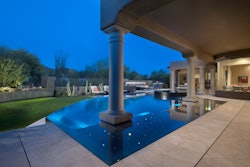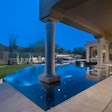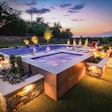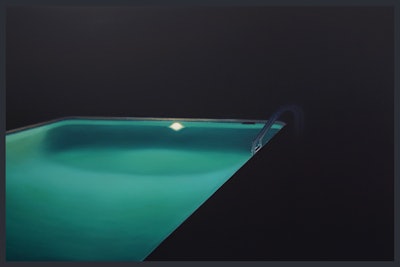
I needed to take a break from work recently, from work recently, so I went to an art show. But even there, the subject of pool lighting followed me.
Check out this painting I saw on the wall (above).
It’s a piece by artist Eric Nash, in a genre you might call nostalgic Americana. It speaks to a collective American reminiscence, and to those with a sentimental longing for the past. Like all good art, it works on multiple levels. But on one simple level, it captures what swimming pool lighting looks like in the minds of millions of Americans.
This matters when we talk about modern pool lighting. A lot of our clients, especially baby boomers, grew up with that aesthetic: a single, blinding-white pool light. It has been burned into their minds as an accepted, normal idea of what pool lighting is “supposed” to be.
Where did this idea of pool lighting come from? For many older Americans, it traces back to that Griswold family vacation, riding in the back of a station wagon with their parents, traveling across the country, hopping from one Motel 6 to the next. At night, they swam in motel pools lit just like the one in the painting above.
Even now, with all the advanced tools we have for lighting swimming pools, this paradigm still holds.
The problem is, despite its long history and millions of installations, this kind of lighting is a visual disaster.
You’re looking right into the deep end of the pool with a light shining right at you, and there’s no background at all. The rich textures of the landscaping? Gone. The stone and masonry around the pool? Gone. All you see is a blinding beacon in your face, coming at you like the headlight of an oncoming train.
SAVOR THE MEMORY, LIVE IN THE PRESENT
In the ever expanding complexity of modern life, there is a move to simplify and get back to basics. It’s good for the soul.
Being reminded of what matters, those immaterial good times of our youth reminds us what that looks like. But some things are worth advancing!
Nowadays, people want more than just a pool. They want an entire backyard experience, and a great outdoor environment with beautiful lighting is an integral part of that.
So how do we create that?
With new tools and better techniques that will enable us to graduate to another level of pool lighting. One of those tools is dimmable pool lights.
GAME CHANGER
Pool lighting used to be basic — a few color options, small LEDs, and a simple on/off switch. You were either bathed in harsh brightness or left in the dark.
We even used to debate whether a well-designed landscape needed pool lighting at all. And for a long time, the answer was no. Keep the lights off. Let the water act as a mirror, reflecting the beauty of the landscape. Only flip the switch when entertaining or when kids are swimming and visibility matters for their safety.
But dimmable lights give us entirely new possibilities — they’re a game changer. The problem with a single, high-wattage pool light (like the one in the painting) is that when you blast too much light into the pool, the rest of the yard disappears. You lose all sense of depth.
With dimmable lighting, you can finally strike a balance — transforming the entire backyard into a unified, intentional composition.

Image A by evening is completely off balance. Even if the background had more light, the two bright bubblers pull your focus and won’t let go.
When lighting is out of balance, it creates visual discomfort, even if you can’t quite pinpoint why. Harsh bright spots leave afterimages and force your eyes to strain as they adjust to what’s beyond the glare.
Here’s another example, image B.

This is exactly what we want to avoid — the Motel 6 experience. Swim across the pool, and you’re on center stage. And no one wants to feel like they’re under a spotlight.
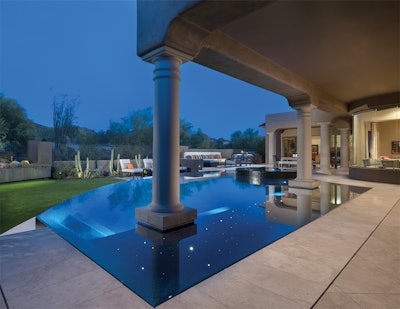
Now, take a look at the photo above. The lighting is balanced — and it works in the photograph. But to capture it, the photographer blended a dozen or so exposures to achieve perfect balance. But today, we can recreate that effect in real life with thoughtful light placement and dimming.
BASIC PRINCIPLES
It all starts with the fundamentals: foreground, middle ground, and background.
To create a compelling nighttime scene, all three
must work together. But in this industry, we often design around the pool first and tack everything else on later. That approach is backwards. When the background becomes an afterthought, the whole composition suffers.
The background matters — a lot. During the day, our eyes naturally scan toward the horizon. That instinct doesn’t disappear at night. Blow out the foreground, and you flatten the entire scene. The eye locks onto the brightest spot, and everything else fades away.
This isn’t just design theory — it’s biology, how our eyes work. Image A shows how powerful contrast is in leading the eye — those three bright light sources, especially the white-hot bubblers, overwhelm the scene. Try to focus on something else. Your eyes snap right back to the glare.
The foreground dominates, pulling all the attention and shrinking the perceived space. What might feel like a beautiful, spacious backyard during the day becomes visually chaotic at night. Lighting leaves no room for neutrality.
Remember that Eric Nash painting? The pool glows like a beacon, and the background disappears completely. That’s exactly what we want to avoid.
So here’s my ask: start with the background. Design that first. When the background is strong, you have something to light toward — a foundation to build around. That’s how you get the foreground, middle ground, and background working in harmony.
PRINCIPLES IN ACTION
Let’s put these ideas into practice.
In this project, we started by positioning the ironwood tree — the star of the show and the anchor of our composition. We placed the spa in front of the tree, but it’s not the subject of this painting. It acts more like a silver platter, reflecting the tree’s image back to the viewer. That vivid desert backdrop becomes the “flower arrangement,” and the pool itself? It’s the glass table in the foyer — elegantly showcasing everything around it.


And now, at night, the deep reflection of the ironwood tree on the spa creates a magical centerpiece for the entire backyard.
When placing landscape lights, avoid visible fixtures. Hide them. Cross-light from the sides. And never aim directly into anyone’s eyes.
In the image below, we’re cross-lighting the spa to achieve that “silver platter” effect — but those lights can be turned off when the spa is in use, avoiding glare and keeping the experience comfortable.
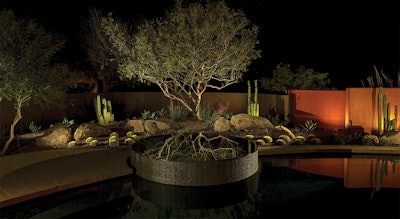
Here’s a different renovation project I worked on with Rick Chafey.
This is the before photo: a bit underwhelming. The lighting falls flat, and at the far end of the pool, there’s that odd Tom Selleck–style mustache — cleverly disguising the abandoned auto cover but not doing much else for the design.

After renovation, here’s that same project at night (see image C at the bottom). With the foreground, middle ground, and background working in unison, the scene finally has depth. And at night, with thoughtful lighting, it all comes together in a cohesive, intentional way.
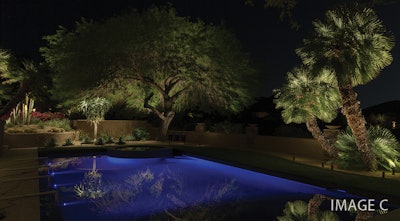
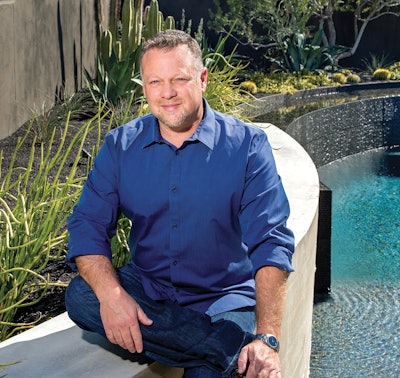
Thoughtful lighting transforms everything.
Here’s the reality: Most people only swim about 3% of the time they’re home. Maybe 10% if they have kids. The rest of the time, the pool is visual. It’s a showpiece. And how it looks matters.


























